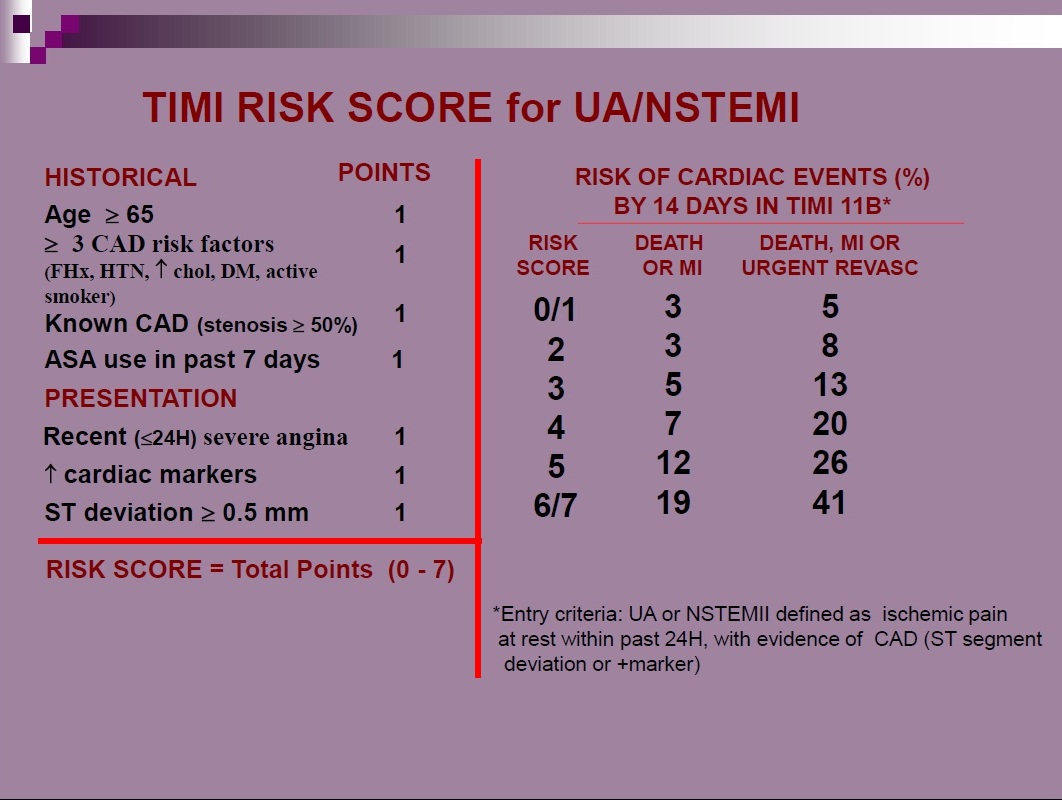

Therefore, the patients who were enrolled in our study were generally at a higher risk. The patients in our study had higher cardiac troponin I levels (26.6 ng/mL in group I and 18.1 ng/mL in group II) as compared with those of other studies. 37%, respectively), TACTICS-TIMI 18 (61% vs. First, the revascularization rate was higher in our study (96.5% for the early invasive strategy group and 78.8% for the late invasive strategy group during hospitalization) as compared with those in the ICTUS (76% vs. There are several possible explanations for the observed differences in outcome between the present study and the previous trials. Our present results were not in accordance with those of the previous trials owing to differences in the study design, particularly the risk profile of patients included and the definition of the end points. We defined the high risk patient who had higher than 5 points of TIMI risk score and when early invasive strategy as door to balloon time was within 48 hours. In our study, an early invasive strategy was better than a late invasive strategy for patients with NSTEMI, especially for the high risk patients. Recent guidelines recommended an early invasive approach for the high-risk NSTEMI patients.
Timi risk score trial#
However, the most recent randomized ICTUS trial showed that an early invasive strategy was not superior to an early conservative strategy, even for the high risk patients, on the short-term and long-term clinical follow-up. An early invasive strategy was shown to be beneficial by the FRISC II, TACTICS-TIMI 18 and RITA-3 studies, especially in the subgroup of patients who were at a high risk, such as those patients presenting with an elevated cardiac troponin level. In five large, randomized trials 18- 22, a routine, early invasive strategy (early angiography followed by revascularization, depending on the angiographic findings) was compared with a "conservative" strategy (angiography and subsequent revascularization only if medical therapy failed or substantial residual ischemia was documented). And the duration of admission to the coronary care unit was significantly longer in group II (3.1 vs. However, for the high risk patients, there was a significantly lower in-hospital mortality in group I (3.3% vs. For the low and moderate and high risk patients, no significant differences of the in-hospital mortality ( p = 0.872, p = 0.052, respectively) were observed between two groups. The patients in both groups were classified into 3 sub-groups according to the TIMI risk score: 742 patients (310 patients of group I and 432 patients of group II) had a TIMI risk score of 0-2 points (the low risk group), 1,556 patients (687 patients of group I and 869 patients of group II) had a TIMI risk score of 3-4 points (the moderate risk group) and 547 patients (237 patients of group I and 310 patients of group II) had a TIMI risk score of 5-7 points (the high risk group). The estimated in-hospital mortality was 2.1% in group I and 4.8% in group II (relative risk: 2.36, 95% confidence interval: 1.51 to 3.71 p < 0.001) ( Table 5). Korea Acute Myocardial Infarction Registry (KAMIR) Study Group of Korean Circulation Society, Korea. 1Department of Internal Medicine, Chonnam National University Hospital, Gwangju, Korea.ĢDepartment of Internal Medicine, Kyungpook National University, Daegu, Korea.ģDepartment of Internal Medicine, Keimyung University Dongsan Medical Center, Daegu, Korea.ĤDepartment of Internal Medicine, Pusan National University Hospital, Busan, Korea.ĥDepartment of Internal Medicine, Yeungnam University Hospital, Daegu, Korea.ĦDepartment of Internal Medicine, Chungnam National University Hospital, Daejeon, Korea.ħDepartment of Internal Medicine, Chonbuk National University Hospital, Jeonju, Korea.ĨDepartment of Internal Medicine, Jeonju Presbyterian Medical Center, Jeonju, Korea.ĩDepartment of Internal Medicine, Seoul National University Bundang Hospital, Seongnam, Korea.ġ0Department of Internal Medicine, National University, Cheongju, Korea.ġ1Department of Internal Medicine, Konyang University, Daejeon, Korea.ġ2Department of Internal Medicine, Korea University Guro Hospital, Seoul, Korea.ġ3Department of Internal Medicine, Kyung Hee University Hospital, Seoul, Korea.ġ4Department of Internal Medicine, Yonsei University Wonju Hospital, Wonju, Korea.ġ5Department of Internal Medicine, Wonju University Hospital, Wonju, Korea.ġ6Department of Internal Medicine, Catholic University Hospital, Seoul, Korea.ġ7Department of Internal Medicine, Asan Medical Center, Seoul, Korea.


 0 kommentar(er)
0 kommentar(er)
